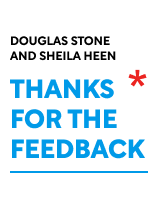

This article is an excerpt from the Shortform book guide to "Thanks for the Feedback" by Douglas Stone and Sheila Heen. Shortform has the world's best summaries and analyses of books you should be reading.
Like this article? Sign up for a free trial here .
How do you react to negative feedback? Does criticism make you act defensive? Why do you think that is?
According to communication experts Douglas Stone and Sheila Heen, the reason some people react defensively to difficult feedback is that it challenges their identity—who they feel they are. You can even be triggered by feedback that isn’t directly about you, but is instead about someone close to you. Because your identity is formed in part by comparison to others and the success of your peers can reflect on your own.
Keep reading to learn how your identity story influences your criticism reception.
Controlling Identity Triggers
Your ability to absorb difficult feedback is controlled by the identity story you tell yourself: who you are and where you are headed. To create an identity story that is robust and resilient rather than brittle, you must:
- Abandon simple identity labels.
- Accept your own complexities.
- Adopt a growth mindset.
- Approach emotional reactions mindfully.
1) Abandon Simple Identity Labels
Labels, as we discussed earlier, are simplified versions of feedback. They can also be simplified versions of identity traits: “I’m competent” or “I’m committed.” Identity labels can help us navigate the choices we run into in daily life: “Should I eat this brownie in the break room? I want to, but I’m not a ‘snacker.’ That’s not who I am.”
However, these types of labels can hurt us because they are “all or nothing” propositions, and an all-or-nothing identity can be destroyed by feedback that challenges the “all” piece of it. All-or-nothing identities leave us with a choice to either abandon our sense of identity or deny the feedback entirely. We might also jump between deciding we are complete failures to deciding the other person is instead. For example, if your identity label says, “I am an excellent storyteller” but your novel doesn’t resonate with your critique partner, you might vacillate between thinking you’re a terrible writer to thinking your partner missed your genius.
When you abandon the simplicity of labels, you recognize that isolated incidents are not necessarily representative of your greater whole. This makes it possible to accept negative feedback as being true while still maintaining your sense of who you are: “My novel is mediocre. I am still, overall, a good writer.”
2) Accept Your Own Complexities
There are three truths you need to accept about yourself that will make it easier to accept feedback:
- You’ll make mistakes: This can be hard to remember when it’s your mistake in question.
- You have complex motives: It can be hard to admit that we don’t always have the best intentions in mind. Sometimes we lie. Sometimes we cut corners. But pursuing self-interest is human, and sometimes that self-interest will conflict with another person’s self-interest.
- You are part of the problem: It can be hard to accept that you’re rarely the sole wronged party in a disagreement.
Accepting each of these truths can feel like a relief, removing some pressure to preserve a veneer of perfection.
3) Adopt a Growth Mindset
Now that you’ve abandoned simple identity labels and accepted your own complexities, let’s discuss how adopting a “growth mindset” can help you bounce back from setbacks.
There are two types of mindsets: “fixed” and “growth.” Which type you have has profound implications for how you view yourself, how you listen to feedback, and how you then respond.
- How we view ourselves: People with fixed mindsets have all-or-nothing outlooks and hear feedback as a referendum on their person, rather than their actions: “Last week I was brilliant; this week, I’m an idiot.” People with growth mindsets are able to accept that they can have both good and bad qualities simultaneously, and they focus more on actions rather than identity: “Last week I nailed my sales pitch; this week I dropped the ball.”
- How we view feedback: People with fixed mindsets pay close attention to the evaluation aspect of feedback, while those with a growth mindset focus more on the coaching aspect. For example, those with fixed mindsets tune out after hearing they’ve answered a question wrong, while those with growth mindsets pay close attention to the subsequent explanation of the correct answer.
- How we respond to feedback: People with fixed mindsets, who view failures as final, often respond to negative feedback by shutting off all efforts and giving up. People with growth mindsets view shortfalls as opportunities for growth and often respond to negative feedback with redoubled efforts.
Adopting a growth mindset is about embracing the learning opportunities inherent in negative feedback. Try to think of your goal as not merely success (the outcome), but instead, the learning you gain, with success being a by-product (process). To move yourself further from a fixed mindset and closer to a growth mindset:
- Listen for coaching rather than evaluation
- Separate judgment from evaluation
- Give yourself a “shadow score”
1. Listen for Coaching, Not Evaluation
Your identity is triggered by evaluation but is far less threatened by coaching. Coaching doesn’t hint at who you are; it relates to what you do, so it’s easier to take.
It can be hard to differentiate the threads sometimes. We sometimes misinterpret coaching as evaluation even if it was intended as coaching: When your friend describes a faster way to the coffee shop, you might hear it as a judgment on your knowledge of the city.
Additionally, coaching and evaluation sometimes come hand-in-hand: When your daughter tells you she was hurt by your emotional absence when she was a child, she is giving you evaluation as well as coaching—she wants to both clear the air and strengthen your relationship moving forward.
Try to focus on the aspect of feedback that aims to change your behavior, not to judge your character. This will help you to get beyond your identity trigger and hear what ultimate take-away from the feedback.
2. Separate Judgment From Evaluation
Evaluation feedback can have three elements:
- Assessment measures you and ranks you.
- Consequences are the tangible results of that assessment: what will happen because of it.
- Judgment is the story that the feedback givers and receivers then tell about the assessment and consequences: how this reflects on you in the other person’s eyes.
Often when you examine your reaction for these three influences, you see that what’s truly upsetting you is the other person’s judgment: her disappointment or her irritation. Recognizing this allows you to then discuss with her exactly what’s bothering you: Maybe you accept the ranking and the results, but don’t feel her attitude about it is appropriate.
3. Give Yourself a “Shadow Score”
When you receive painful evaluation, rate yourself on how well you handle it. In this way, even if you fail your evaluation from the other person, you can still get something positive out of the experience. For example, after a divorce (a negative evaluation from your spouse), you might note that you are doing very well in dealing with that feedback—you’re staying sober, continuing to exercise, and continuing to make gains at work.
Recognizing how you handle bad feedback helps you gain control of those reactions and help you see that the initial evaluation is not the end of your story. The more important story might be the learning you take away from the experience (again, bolstering a growth mentality).
(Shortform note: To learn more about how to develop a growth mindset, read our summary of Grit.)
4) Approach Emotional Reactions Thoughtfully
You can further counter your emotional reactions by approaching them thoughtfully. Follow five steps:
- Be prepared and mindful
- Separate the story from the feelings
- Contain the story
- Change your point of view
- Accept the limits of your control
1. Be Prepared and Mindful
Examine your behavioral patterns and habits so that you’re prepared for feedback when you receive it.
- Recognize your reaction patterns: Everyone has their own set of knee-jerk behaviors that are activated in response to feedback. Some people blame others; some people switchtrack; some grow silent; some apologize. We often, of course, don’t see our own patterns. If you’re not sure, ask someone else.
- Imagine the worst-case scenario: When you’re anticipating news, you can inoculate yourself against your own knee-jerk reactions by imagining the news is bad and thinking through all the consequences that might result. Like a vaccine, this will prepare your mind for whatever may come. You can even go one step further and talk to people who’ve dealt with similar circumstances. You’re afraid your house won’t appraise? Maybe your neighbor dealt with a similar situation—ask her what her next steps were.
- Be aware in the moment: When you start to feel yourself get an emotional reaction of any kind, slow down and acknowledge it. Putting words to it robs it of its power to control your reactions.
2. Separate the Story From the Feelings
Name your feelings explicitly so that you can judge how they are affecting your interpretation of the feedback. Ask yourself three questions:
- What do I feel? Name not only the feeling (anger? anxiety? shame?) but also the physical symptoms the feeling is producing. Do you feel a shock of adrenaline? Does your stomach squeeze?
- What’s the story I’m telling myself? Don’t worry about whether your story is right or wrong for the moment—just consciously recognize it. Pay special attention to the threat that’s embedded in your story. Is it something you fear will happen as a result, like losing your job or status in your community?
- What’s the actual feedback? Remind yourself of what the feedback-giver actually said to you: not what you’ve inserted, but what was actually said.
It’s possible that the negative details you’ve added to the story are correct. But it’s also possible they’re not. Be clear about what you’ve added and you’ll better see what the real threats are, not the ones your emotions are inventing.
3. Contain the Story
When we are in a negative frame of mind, we can lose perspective and imagine the worst of every piece of feedback we receive. Sometimes it helps us see things in perspective if we actually see them, visually. Take a piece of paper and make two columns: one for what the feedback is about, and one for what it is not about. Compare the two. Or, take a piece of paper and draw smiley faces for every piece of good feedback you’ve received, and frowny faces for the bad. You may be surprised at the sea of smiles.
4. Change Your Point of View
Changing your perspective on a situation can shed new light on it and snap you out of a dark story. A few techniques can help you do this:
- Imagine you’re an observer: You can usually see feedback about another person more clearly than you can about yourself. Try to imagine that the feedback is being given about someone else—your sister, perhaps—and ask how you’d advise her to react. Even as a mere thought experiment the insights can be revealing. Once you’ve shifted perspectives, you can advise yourself as if you were another person.
- Look at it from the future: Picture yourself ten or twenty years from now, and ask your (future) self how significant today’s events are going to seem at that time. You may still attach importance to the issue, of course, but you’re likely to place less importance on it in the future than you are now, and you might even regret the time you’ve spent worrying about it.
- Frame it as a comedy: Many of the things you worry about today, you laugh about tomorrow. The sooner you get to that mindset, the better. Humor forces your brain into a different emotional state, disrupting your panic. When you can see the humor in your situation, you become more emotionally detached from it and better able to accept feedback on it.
5. Accept the Limits of Your Control
As humans, we’re wired to care deeply about what others think about us. We can sometimes fall into a trap of trying to make others view us in a particular way. Accept that this is not something you have control over. Maybe you get the feeling that your colleague doesn’t like you. You’re not going to turn her around by bringing her sweets and peppering her with jokes. You might never turn her around, but that’s her decision, not yours.
The sooner you accept that you can’t control what others think and feel about you, the sooner you’ll be able to control your emotional reaction to their feedback.
Ask for Help When You Need It
There are times when no matter how hard we try, and how many of these techniques we attempt, we still can’t get control over our emotional responses to feedback. Although emotional distress can be helpful when it forces us to re-evaluate ourselves and face our problems, distress that lingers can be devastating, turning into long-term anxiety, causing depression, lowering our abilities to function, and in the worst cases, leading to suicidal thoughts.
When you find you just can’t contain your emotional responses to feedback, it may be time to seek outside help. Ask for support from friends, family, your community, or religion. Seek professional help through therapy, medication, or even hospitalization if needed.

———End of Preview———
Like what you just read? Read the rest of the world's best book summary and analysis of Douglas Stone and Sheila Heen's "Thanks for the Feedback" at Shortform .
Here's what you'll find in our full Thanks for the Feedback summary :
- How to better receive feedback, rather than just giving it
- Why people tend to respond negatively towards feedback
- How to successfully incorporate feedback into your life






